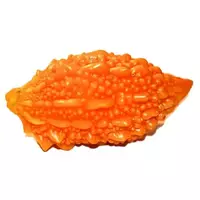Bitter pumpkin momordica

The bitter pumpkin momordica or Momordica is a species in the Pumpkin family and is an evergreen plant that is distributed predominantly in countries with tropical or subtropical climates. Currently, botanists have discovered, studied, and also described over two dozen varieties of momordics. The birthplace of bitter momordica pumpkin is considered to be the region of Southeast Asia, Australia, as well as Africa. Among the most famous and widely used in both cooking and folk medicine, species of bitter momorica pumpkin include the following:
Chinese bitter pumpkin momordica charantia;
mixed momordica (Latin: Momordica cochinchinensis) or gak.
These two main types of plant differ not only in taste and other consumer characteristics. Depending on the variety of the plant, the chemical composition changes, as well as the properties of momordics. The Chinese bitter pumpkin momordica is an annual plant that tends to be native to Southeast Asia, China, as well as the Caribbean islands. Often, the Chinese bitter pumpkin momrdika is called nothing more than a bitter cucumber.
In its appearance, the bitter pumpkin momordica really resembles the famous vegetable cucumber. Initially, the green fruits of the plant in the active ripening phase change their color scheme. As a result, the fruits of the momordica acquire their characteristic bright yellow or even orange color. It is noteworthy that the flesh of the momordica differs in color from the wrinkled peel of the plant. The pale green flesh of the fruit of the plant has a dense consistency and is distinguished by its bitter taste.
The fruits of the Chinese bitter pumpkin momordica have long been used in the cooking of the peoples of Asia, Africa and Australia. the green momordica fruits are harvested and then soaked for some time in salted aqueous solution. As a result, momordica loses its bitterness and becomes suitable for consumption. Chinese bitter pumpkin momordica is prepared in a variety of ways. For example, they simmer, fry or bake, as well as marinate and preserve.
The useful properties of momordics have long been used in medicines of traditional Asian medicine. For example, bitter momordic pumpkin helps in the treatment of arthritis, asthma, diabetes or arthritis. The vitamin and mineral composition of momrdika speaks for itself. The composition of the plant contains twice as much iron, calcium, potassium and beta-carotene, in comparison with such leaders in the content of the above compounds as bananas, broccoli and spinach. The mixed momordica of Kohinha differs from the bitter Chinese pumpkin in its appearance as well as its scope of use.
Orange and relatively smooth fruits of mixed momordics are used to make oil, which has incredible healing abilities. Mixed hag or momordic oil contains a record amount of vitamin A. Hag oil treats various lesions of the skin, for example burns. momordic oil soothes the human nervous system. In addition, hook oil helps strengthen the immune system. In general, both the momordic plant itself and the hook oil have a beneficial and positive effect on the human body as a whole.
bitter pumpkin momordic 19 kKal
The energy value of bitter pumpkin momordic (Ratio of proteins, fats, carbohydrates - ju):
Proteins: 0.1 g (~ 0 kCal)
Fats: 0.1 g (~ 1 kCal)
Carbohydrates: 0.1 g (~ 0 kCal)
Energy ratio (bj | y): 2% | 5% | 2%
 Español
Español Français
Français Português
Português Русский
Русский 简体中文
简体中文 繁體中文
繁體中文 日本語
日本語 한국어
한국어 العربية
العربية Türkçe
Türkçe Қазақ
Қазақ Deutsch
Deutsch Italiano
Italiano Українська
Українська
